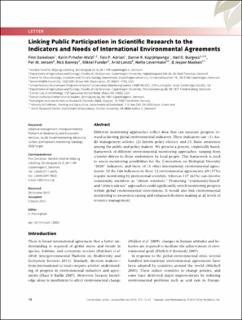Linking public participation in scientific research to the indicators and needs of international environmental agreements
Danielsen, Finn; Pirhofer-Walzl, Karin; Adrian, Teis P.; Kapijimpanga, Daniel R.; Burgess, Neil D.; Jensen, Per M.; Bonney, Rick; Funder, Mikkel; Landa, Arild Magne; Levermann, Nette; Madsen, Jesper
Peer reviewed, Journal article
Published version

Åpne
Permanent lenke
https://hdl.handle.net/11250/3085039Utgivelsesdato
2014Metadata
Vis full innførselSamlinger
- Publikasjoner fra CRIStin - NINA [2364]
- Scientific publications [1392]
Sammendrag
Different monitoring approaches collect data that can measure progress toward achieving global environmental indicators. These indicators can: (1) Audit management actions; (2) Inform policy choices; and (3) Raise awareness among the public and policy makers. We present a generic, empirically based, framework of different environmental monitoring approaches, ranging from scientist-driven to those undertaken by local people. This framework is used to assess monitoring possibilities for the Convention on Biological Diversity “2020” indicators, and those of 11 other international environmental agreements. Of the 186 indicators in these 12 environmental agreements, 69 (37%) require monitoring by professional scientists, whereas 117 (63%) can involve community members as “citizen scientists.” Promoting “community-based” and “citizen science” approaches could significantly enrichmonitoring progress within global environmental conventions. It would also link environmental monitoring to awareness raising and enhanced decision-making at all levels of resource management. Adaptive management; Intergovernmental Platform on Biodiversity and Ecosystem Services; locally based monitoring; observing system; participatory monitoring; typology; 2020 target. Linking public participation in scientific research to the indicators and needs of international environmental agreements
